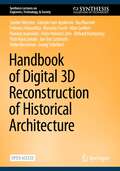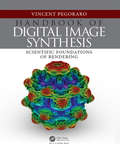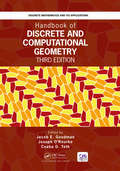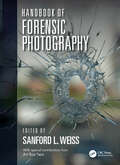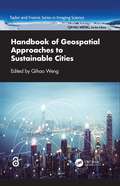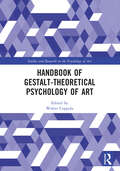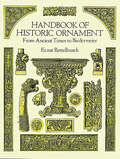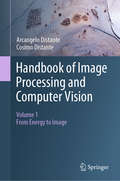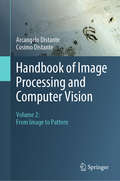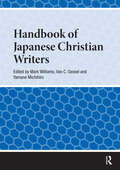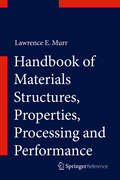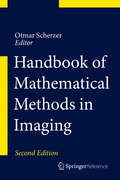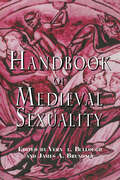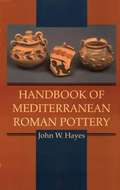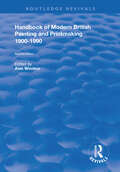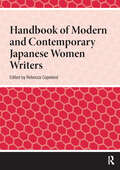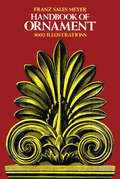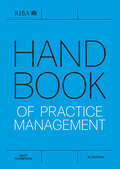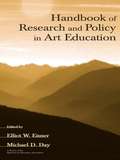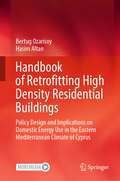- Table View
- List View
Handbook of Digital 3D Reconstruction of Historical Architecture (Synthesis Lectures on Engineers, Technology, & Society #28)
by Sander Münster Piotr Kuroczyński Marinos Ioannides Heike Messemer Fabrizio Ivan Apollonio Ina Bluemel Federico Fallavollita Riccardo Foschi Marc Grellert Peter Heinrich Jahn Richard Kurdiovsky Jan-Eric Lutteroth Georg SchelbertThis open access book is a handbook for students, experts and interested parties who want to learn more about digital 3D reconstruction of historical architecture. The book provides answers to the core questions of the subject: What is a digital 3D model or a digital 3D reconstruction? How are they created and what are they used for? Practical instructions, condensed knowledge, explanations of technical terms and references to example projects, literature and further references provide information of varying density and thus enable an individual introduction to the subject.The book combines extensive knowledge on the topic of "digital 3D reconstruction of historical architecture" and provides practical instructions for independent implementation. Up to now, there has been no cross-disciplinary vocabulary for technical terms in this field, so this publication makes a start.The book is aimed at students, experts in the field and the interested public and offers various possibilities for the different target groups to delve deeply into the subject.The book was created within the research network "Digital 3D Reconstruction as Tools for Research in Architectural History," which was funded by the German Research Foundation (DFG) from 2018 to 2023. The authors combined their expertise in the fields of art and architectural history, architecture, university teaching and media informatics.
Handbook of Digital Image Synthesis: Scientific Foundations of Rendering
by Vincent PegoraroThe Handbook of Digital Image Synthesis is the most up-to-date reference guide in the rapidly developing field of computer graphics. A wide range of topics, such as, applied mathematics, data structures, and optical perception and imaging help to provide a well-rounded view of the necessary formulas for computer rendering. In addition to this diverse approach, the presentation of the material is substantiated by numerous figures and computer-generated images. From basic principles to advanced theories, this book, provides the reader with a strong foundation of computer formulas and rendering through a step-by-step process. . Key Features: Provides unified coverage of the broad range of fundamental topics in rendering Gives in-depth treatment of the basic and advanced concepts in each topic Presents a step-by-step derivation of the theoretical results needed for implementation Illustrates the concepts with numerous figures and computer-generated images Illustrates the core algorithms using platform-independent pseudo-code
Handbook of Discrete and Computational Geometry (Discrete Mathematics and Its Applications)
by Jacob E. Goodman Csaba D. Tóth Joseph O’RourkeThe Handbook of Discrete and Computational Geometry is intended as a reference book fully accessible to nonspecialists as well as specialists, covering all major aspects of both fields.The book offers the most important results and methods in discrete and computational geometry to those who use them in their work, both in the academic world—as researchers in mathematics and computer science—and in the professional world—as practitioners in fields as diverse as operations research, molecular biology and robotics.Discrete geometry has contributed significantly to the growth of discrete mathematics in recent years. This has been fueled partly by the advent of powerful computers and by the recent explosion of activity in the relatively young field of computational geometry. This synthesis between discrete and computational geometry lies at the heart of this Handbook.A growing list of application fields includes combinatorial optimization, computer-aided design, computer graphics, crystallography, data analysis, error-correcting codes, geographic information systems, motion planning, operations research, pattern recognition, robotics, solid modeling, and tomography.
Handbook of Face Recognition
by Stan Z. Li Anil K. JainThis highly anticipated new edition provides a comprehensive account of face recognition research and technology, spanning the full range of topics needed for designing operational face recognition systems. After a thorough introductory chapter, each of the following chapters focus on a specific topic, reviewing background information, up-to-date techniques, and recent results, as well as offering challenges and future directions. Features: fully updated, revised and expanded, covering the entire spectrum of concepts, methods, and algorithms for automated face detection and recognition systems; provides comprehensive coverage of face detection, tracking, alignment, feature extraction, and recognition technologies, and issues in evaluation, systems, security, and applications; contains numerous step-by-step algorithms; describes a broad range of applications; presents contributions from an international selection of experts; integrates numerous supporting graphs, tables, charts, and performance data.
Handbook of Food Factory Design
by Christopher G. BakerFood manufacturing has evolved over the centuries from kitchen industries to modern, sophisticated production operations. A typical food factory includes the food processing and packaging lines, the buildings and exterior landscaping, and the utility-supply and waste-treatment facilities. As a single individual is unlikely to possess all the necessary skills required to facilitate the design, the task will undoubtedly be undertaken by an interdisciplinary team employing a holistic approach based on a knowledge of the natural and biological sciences, most engineering disciplines, and relevant legislation. In addition, every successful project requires a competent project manager to ensure that all tasks are completed on time and within budget. This Handbook attempts to compress comprehensive, up-to-date coverage of these areas into a single volume. It is hoped that it will prove to be of value across the food-manufacturing community. The multi-disciplinary nature of the subject matter should facilitate more informed communication between individual specialists on the team. It should also provide useful background information on food factory design for a wider range of professionals with a more peripheral interest in the subject: for example, process plant suppliers, contractors, HSE specialists, retailers, consultants, and financial institutions. Finally, it is hoped that it will also prove to be a valuable reference for students and instructors in the areas of food technology, chemical engineering, and mechanical engineering, in particular.
Handbook of Forensic Photography
by Sanford L WeissHandbook of Forensic Photography is the most-comprehensive, definitive reference for the use of photography in the capture and presentation of forensic evidence. The intent is to inform the reader about the most complete and up-to-date methods to capture and reproduce images that most accurately represent the evidence. With the rise in importance of forensic science, crime and accident scene documentation has likewise increased in importance—not the least of which has been forensic photography. The need to use accepted practice and protocols to guarantee the authenticity of images for evidence documentation is paramount for using it in court. And as with any discipline, there is an art to the science of forensic photography. Contributing authors from various backgrounds—each experts in their field—have provided numerous case examples, best practices, and recommendations for recognizing, recording, and preserving evidence using cameras and the latest digital image technology, including video and other imaging technologies. Chapters present such topics as videography, drone photography, underwater photography, crime scene photography, autopsy photographs, fire documentation, forensic odontology, and more. The book closes with coverage of courtroom displays, presenting imaging evidence and expert witness testimony in the courtroom. Handbook of Forensic Photography is a must-have reference for experienced crime scene photographers, death and crime scene investigators, police, and forensic professionals—including medical examiners, odontologists, engineers, and forensic anthropologists—who frequently need to capture investigative photographs in the course of investigations.
Handbook of Geospatial Approaches to Sustainable Cities (Imaging Science)
by Qihao Weng Cheolhee YooThis comprehensive handbook presents the current state of knowledge on geospatial technologies, techniques, and methods that are imperative for providing solutions to sustainable cities. It addresses the role of geospatial big data and AI techniques and how they are applied when analyzing the sustainability of urban development, land use, urban planning, and resource management, as well as monitoring the impact urbanization has on the environment and the ecosystem. Taking an interdisciplinary approach to sustainable cities, and with contributions from renowned experts around the world, this holistic handbook is a toolbox for geospatial, urban, and sustainability professionals, the artificial intelligence community, and those who work in related fields.Features: Explores cutting-edge geospatial and AI techniques in support of efficient, resilient, digital, and smart cities Bridges urban science and sustainability science via geospatial methods Contributes to the efforts of GEO by addressing and exemplifying pertinent societal benefit areas and engagement priorities Includes 16 case studies with a broad geographic scope that integrate societal needs with technological advances Draws expertise in geospatial technology, big data, and artificial intelligence from leading experts in the world This book is intended for researchers and scientists interested in learning techniques in GeoAI, including the technologies for collecting, analyzing, managing, processing, and visualizing geospatial datasets. Chapters 3, 6, 7, 8, and 15 of this book are freely available as a downloadable Open Access PDF at http://www.taylorfrancis.com under a Creative Commons Attribution-Non Commercial-No Derivatives (CC BY-NC-ND) 4.0 license.
Handbook of Gestalt-Theoretical Psychology of Art (Studies and Research in the Psychology of Art)
by Walter CoppolaThe Handbook of Gestalt-Theoretic Psychology of Art synthesizes contemporary research in the psychology of perception, cognition, language and hearing to reassess the Gestalt approach to studying the arts.Since Rudolf Arnheim’s death in 2007, the field has seen a resurgence, with scientists revisiting and reinventing previously articulated points of view. For the first time, this new work is gathered in a single comprehensive resource. Beginning with a history of the field, the book considers meta-theoretic issues before discussing the various senses. It explores topics including aesthetics, space, poetry, literature, music, and film, bringing together leading researchers from across the discipline.It will be an essential read for all students and researchers of the psychology of art, the psychology of perception, or Gestalt Theory.
Handbook of Historic Ornament (Dover Pictorial Archive)
by Ernst RettelbuschClassic resource contains over 1,200 examples of ornamental and decorative design produced by many cultures over five millennia. Assyrian, Greek, Roman, Byzantine; European Renaissance, Baroque, Rococo; English furniture designs by Chippendale, Sheraton and Hepplewhite; French Empire; Nordic motifs; Chinese and Japanese material, much more. Royalty-free. 254 plates.
Handbook of Human Centric Visualization
by Weidong HuangVisualizations are visual representations of non-visual data. They are produced for people to interact with and to make sense of the underlying data. Rapid advances in display technology and computer power have enabled researchers to produce visually appealing pictures. However, the effectiveness of those pictures in conveying the embedded information to end users has not been fully explored. Handbook of Human Centric Visualization addresses issues related to design, evaluation and application of visualizations. Topics include visualization theories, design principles, evaluation methods and metrics, human factors, interaction methods and case studies. This cutting-edge book includes contributions from well-established researchers worldwide, from diverse disciplines including psychology, visualization and human-computer interaction. This handbook is designed for a professional audience composed of practitioners, lecturers and researchers working in the field of computer graphics, visualization, human-computer interaction and psychology. Undergraduate and postgraduate students in science and engineering focused on this topic will also find this book useful as a comprehensive textbook or reference.
Handbook of Image Processing and Computer Vision: Volume 1: From Energy to Image
by Cosimo Distante Arcangelo DistanteAcross three volumes, the Handbook of Image Processing and Computer Vision presents a comprehensive review of the full range of topics that comprise the field of computer vision, from the acquisition of signals and formation of images, to learning techniques for scene understanding. The authoritative insights presented within cover all aspects of the sensory subsystem required by an intelligent system to perceive the environment and act autonomously. Volume 1 (From Energy to Image) examines the formation, properties, and enhancement of a digital image.Topics and features:• Describes the fundamental processes in the field of artificial vision that enable the formation of digital images from light energy• Covers light propagation, color perception, optical systems, and the analog-to-digital conversion of the signal• Discusses the information recorded in a digital image, and the image processing algorithms that can improve the visual qualities of the image• Reviews boundary extraction algorithms, key linear and geometric transformations, and techniques for image restoration• Presents a selection of different image segmentation algorithms, and of widely-used algorithms for the automatic detection of points of interest• Examines important algorithms for object recognition, texture analysis, 3D reconstruction, motion analysis, and camera calibration• Provides an introduction to four significant types of neural network, namely RBF, SOM, Hopfield, and deep neural networksThis all-encompassing survey offers a complete reference for all students, researchers, and practitioners involved in developing intelligent machine vision systems. The work is also an invaluable resource for professionals within the IT/software and electronics industries involved in machine vision, imaging, and artificial intelligence.Dr. Cosimo Distante is a Research Scientist in Computer Vision and Pattern Recognition in the Institute of Applied Sciences and Intelligent Systems (ISAI) at the Italian National Research Council (CNR). Dr. Arcangelo Distante is a researcher and the former Director of the Institute of Intelligent Systems for Automation (ISSIA) at the CNR. His research interests are in the fields of Computer Vision, Pattern Recognition, Machine Learning, and Neural Computation.
Handbook of Image Processing and Computer Vision: Volume 2: From Image to Pattern
by Cosimo Distante Arcangelo DistanteAcross three volumes, the Handbook of Image Processing and Computer Vision presents a comprehensive review of the full range of topics that comprise the field of computer vision, from the acquisition of signals and formation of images, to learning techniques for scene understanding. The authoritative insights presented within cover all aspects of the sensory subsystem required by an intelligent system to perceive the environment and act autonomously. Volume 2 (From Image to Pattern) examines image transforms, image restoration, and image segmentation.Topics and features:• Describes the fundamental processes in the field of artificial vision that enable the formation of digital images from light energy• Covers light propagation, color perception, optical systems, and the analog-to-digital conversion of the signal• Discusses the information recorded in a digital image, and the image processing algorithms that can improve the visual qualities of the image• Reviews boundary extraction algorithms, key linear and geometric transformations, and techniques for image restoration• Presents a selection of different image segmentation algorithms, and of widely-used algorithms for the automatic detection of points of interest• Examines important algorithms for object recognition, texture analysis, 3D reconstruction, motion analysis, and camera calibration• Provides an introduction to four significant types of neural network, namely RBF, SOM, Hopfield, and deep neural networksThis all-encompassing survey offers a complete reference for all students, researchers, and practitioners involved in developing intelligent machine vision systems. The work is also an invaluable resource for professionals within the IT/software and electronics industries involved in machine vision, imaging, and artificial intelligence.Dr. Cosimo Distante is a Research Scientist in Computer Vision and Pattern Recognition in the Institute of Applied Sciences and Intelligent Systems (ISAI) at the Italian National Research Council (CNR). Dr. Arcangelo Distante is a researcher and the former Director of the Institute of Intelligent Systems for Automation (ISSIA) at the CNR. His research interests are in the fields of Computer Vision, Pattern Recognition, Machine Learning, and Neural Computation.
Handbook of Image Processing and Computer Vision: Volume 3: From Pattern to Object
by Cosimo Distante Arcangelo DistanteAcross three volumes, the Handbook of Image Processing and Computer Vision presents a comprehensive review of the full range of topics that comprise the field of computer vision, from the acquisition of signals and formation of images, to learning techniques for scene understanding. The authoritative insights presented within cover all aspects of the sensory subsystem required by an intelligent system to perceive the environment and act autonomously. Volume 3 (From Pattern to Object) examines object recognition, neural networks, motion analysis, and 3D reconstruction of a scene.Topics and features:• Describes the fundamental processes in the field of artificial vision that enable the formation of digital images from light energy• Covers light propagation, color perception, optical systems, and the analog-to-digital conversion of the signal• Discusses the information recorded in a digital image, and the image processing algorithms that can improve the visual qualities of the image• Reviews boundary extraction algorithms, key linear and geometric transformations, and techniques for image restoration• Presents a selection of different image segmentation algorithms, and of widely-used algorithms for the automatic detection of points of interest• Examines important algorithms for object recognition, texture analysis, 3D reconstruction, motion analysis, and camera calibration• Provides an introduction to four significant types of neural network, namely RBF, SOM, Hopfield, and deep neural networksThis all-encompassing survey offers a complete reference for all students, researchers, and practitioners involved in developing intelligent machine vision systems. The work is also an invaluable resource for professionals within the IT/software and electronics industries involved in machine vision, imaging, and artificial intelligence.Dr. Cosimo Distante is a Research Scientist in Computer Vision and Pattern Recognition in the Institute of Applied Sciences and Intelligent Systems (ISAI) at the Italian National Research Council (CNR). Dr. Arcangelo Distante is a researcher and the former Director of the Institute of Intelligent Systems for Automation (ISSIA) at the CNR. His research interests are in the fields of Computer Vision, Pattern Recognition, Machine Learning, and Neural Computation.
Handbook of Japanese Christian Writers (Handbooks on Japanese Studies)
by Van C. Gessel Mark Williams Yamane MichihiroAlthough a century and a half of Christian proselytizing has only led to the conversion of about one percent of the Japanese population, the proportion of writers who have either been baptized or significantly influenced in their work by Christian teachings is much higher. The seventeen authors examined in this volume have all employed themes and imagery in their writings influenced by Christian teachings. Those writing between the 1880s and the start of World War II were largely drawn to the Protestant emphasis on individual freedom, though many of them eventually rejected sectarian affiliation. Since 1945, on the other hand, Catholicism has produced a number of religiously committed authors, led by figures such as Endo Shusaku, the most popular and influential Christian writer in Japan to date. The authors discussed in these essays have contributed in a variety of ways to the indigenization of the imported religion.
Handbook of Low Temperature District Heating (Green Energy and Technology)
by Roberto Garay-Martinez Antonio Garrido-MarijuanThis book reviews the history and evolution of district heating networks, with a focus on current and future issues of the district heating sector. Novel developments in the field of low temperature district heating are studied, limitations for safe operation and avoidance of bacteria are considered, and the associated improved performance of the system with fewer network losses is presented.This book showcases how the evolution of district heating networks is linked to the increased use of renewables and de-carbonized heat sources with specific focus to waste heat streams and solar energy systems. Considering the novelty of these technologies, technological developments and funding schemes for these investments are still immature to some extent. For that reason, a comprehensive review of the main aspects of energy planning as well as district heating economics and financing schemes for large-scale investments in renewable energy systems for district energy systems is performed.In the light of digitalization, networks are increasingly monitored, allowing for a drastic change in the approach for network operation. This book also explores the increased digitization and monitoring of networks and how this impacts network operation.This book is of interest to engineers, academics and officials interested in energy systems, presenting readers with the key concepts and tools to adapt to the evolution of district heating into an integrated, digitized and higher performing system.
Handbook of Materials Structures, Properties, Processing and Performance
by Lawrence E. MurrThis extensive knowledge base provides a coherent description of advanced topics in materials science and engineering with an interdisciplinary/multidisciplinary approach. The book incorporates a historical account of critical developments and the evolution of materials fundamentals, providing an important perspective for materials innovations, including advances in processing, selection, characterization, and service life prediction. It includes the perspectives of materials chemistry, materials physics, engineering design, and biological materials as these relate to crystals, crystal defects, and natural and biological materials hierarchies, from the atomic and molecular to the macroscopic, and emphasizing natural and man-made composites. This expansive presentation of topics explores interrelationships among properties, processing, and synthesis (historic and contemporary). The book serves as both an authoritative reference and roadmap of advanced materials concepts for practitioners, graduate-level students, and faculty coming from a range of disciplines.
Handbook of Mathematical Methods in Imaging
by Otmar ScherzerThe Handbook of Mathematical Methods in Imaging provides a comprehensive treatment of the mathematical techniques used in imaging science. The material is grouped into two central themes, namely, Inverse Problems (Algorithmic Reconstruction) and Signal and Image Processing. Each section within the themes covers applications (modeling), mathematics, numerical methods (using a case example) and open questions. Written by experts in the area, the presentation is mathematically rigorous. The entries are cross-referenced for easy navigation through connected topics. Available in both print and electronic forms, the handbook is enhanced by more than 150 illustrations and an extended bibliography. It will benefit students, scientists and researchers in applied mathematics. Engineers and computer scientists working in imaging will also find this handbook useful.
Handbook of Medieval Sexuality (Reference Library Of The Humanities #Vol. 1696)
by James A. Brundage Vern L. BulloughLike specialists in other fields in humanities and social sciences, medievalists have begun to investigate and write about sex and related topics such as courtship, concubinage, divorce, marriage, prostitution, and child rearing. The scholarship in this significant volume asserts that sexual conduct formed a crucial role in the lives, thoughts, hopes and fears both of individuals and of the institutions that they created in the middle ages.The absorbing subject of sexuality in the Middle Ages is examined in 19 original articles written specifically for this "Handbook" by the major authorities in their scholarly specialties. The study of medieval sexuality poses problems for the researcher: indices in standard sources rarely refer to sexual topics, and standard secondary sources often ignore the material or say little about it. Yet a vast amount of research is available, and the information is accessible to the student who knows where to look and what to look for. This volume is a valuable guide to the material and an indicator of what subjects are likely to yield fresh scholarly rewards.
Handbook of Mediterranean Roman Pottery
by John W. HayesIn the past, Roman pottery has been judged as inferior to Greek pottery. Recent excavations, however, have led to an increase in knowledge and appreciation of Roman wares. These wares now constitute an important body of evidence for the understanding of art, literacy and trade in the ancient world. John W. Hayes, the acknowledged authority in this field, explains the particular features that mark Roman-period wares, concisely describing how the vessels were manufactured, decorated, traded and used. Placing the pottery in historical context, he describes its roots in the Hellenistic Greek tradition, its evolution as a distinct art form and its influence on Byzantine and Islamic trends.
Handbook of Modern British Painting and Printmaking 1900-90 (Routledge Revivals)
by Alan WindsorOriginally published in 1998, The Handbook of Modern British Painting and Printmaking 1900-1990 has been designed for people who enjoy, study and buy British art. The only portable dictionary-style guide to the life and work of modern British painters and printmakers, the book provides information on some 2,000 artists, as well as entries on schools of art, on museums, galleries and collections, on societies and groups, and critics and patrons who have influenced the development of modern art in Britain. Compiled by scholars, the entries are cross-referenced and each concise biographical outline provides the relevant facts about the artist's life, a brief characterisation of the artist's work, and major bibliographic references. Wherever possible, one or two suggestions for further reading are cited.
Handbook of Modern and Contemporary Japanese Women Writers (Handbooks on Japanese Studies)
by Rebecca CopelandThe Handbook of Modern and Contemporary Japanese Women Writers offers a comprehensive overview of women writers in Japan, from the late 19th century to the early 21st. Featuring 24 newly written contributions from scholars in the field—representing expertise from North America, Europe, Japan, and Australia—the Handbook introduces and analyzes works by modern and contemporary women writers that coalesce loosely around common themes, tropes, and genres. Putting writers from different generations in conversation with one another reveals the diverse ways they have responded to similar subjects. Whereas women writers may have shared concerns—the pressure to conform to gendered expectation, the tension between family responsibility and individual interests, the quest for self-affirmation—each writer invents her own approach. As readers will see, we have writers who turn to memoir and autobiography, while others prefer to imagine fabulous fictional worlds. Some engage with the literary classics—whether Japanese, Chinese, or European—and invest their works with rich intertextual allusions. Other writers grapple with colonialism, militarism, nationalism, and industrialization. This Handbook builds a foundation which invites readers to launch their own investigations into women’s writing in Japan.
Handbook of Ornament: A Grammar Of Art, Industrial And Architectural Designing In All Its Branches, For Practical As Well As Theoretical Use (classic Reprint) (Dover Pictorial Archive Ser.)
by Franz Sales MeyerRepublished unabridged from the final comprehensive edition, this work contains the largest single-volume collection of classical art motifs ever compiled. It reproduces material from Greek and Roman, medieval European, Islamic, Renaissance, baroque, and early nineteenth-century art, architecture, and design — in all, presenting artists, crafters, and students with more than 3,000 designs.Featured design elements include networks, Gothic tracery, geometric designs, akanthos leaves, lotus ornamentation, animal ornamentation, grotesque figures, fret bands, chains, interlacements, rosettes, undulations, spirals, link borders, cresting borders, finials, crockets, gargoyles, foliations, panels, repeated ornaments, and hundreds of other elements. Other plates show decorated pottery vases, religious utensils, weapons, furniture, lamps, jewelry, and other artifacts, in addition to heraldic motifs and ornamental letters.
Handbook of Practice Management
by Matt ThompsonSeeking advice on practice management? This new edition of RIBA’s (Royal Institute of British Architects) classic handbook brings guidance right up to date. It covers the full deck of management competencies, including how to run your finances, win work, employ people, operate your office, handle information, assure quality, and manage your risks.In print for 50 years, this enduring reference book has been comprehensively restructured and modernised to reflect the latest changes in practice. Aimed at those who are already managing a design studio or setting up a practice, it provides advice on all aspects of practising architecture in the UK and is a core reference book for practitioners and students alike.Divided into two parts, the first characterises and quantifies the business of designing buildings in the context of the construction industry. It outlines what it means to be a member of the architect profession and considers the trends that seem likely to influence its future direction.The second part sets out the overlapping activities that together constitute practice management. A chapter on business strategy is followed by seven topic-specific chapters organised to: Distinguish between what you must do by law, what you should do to conform to professional codes of conduct, and what you might do to compete in the market Outline the most important management considerations Highlight the tactics and tools available to you Signpost useful resources and sources of more detailed information. A must-have handbook for chartered members of RIBA (Royal Institute of British Architects) and ARB (Architects Registration Board) registered architects. The guidance accounts for architects’ duties under ARB’s Architects Code; and chartered members’ duties under the RIBA Code of Professional Conduct and chartered practices’ duties under the RIBA Code of Professional Practice.
Handbook of Research and Policy in Art Education
by Elliot W. Eisner Michael D. DayThe Handbook of Research and Policy in Art Education marks a milestone in the field of art education. Sponsored by the National Art Education Association and assembled by an internationally known group of art educators, this 36-chapter handbook provides an overview of the remarkable progress that has characterized this field in recent decades. Organized into six sections, it profiles and integrates the following elements of this rapidly emerging field: history, policy, learning, curriculum and instruction, assessment, and competing perspectives. Because the scholarly foundations of art education are relatively new and loosely coupled, this handbook provides researchers, students, and policymakers (both inside and outside the field) an invaluable snapshot of its current boundaries and rapidly growing content. In a nutshell, it provides much needed definition and intellectual respectability to a field that as recently as 1960 was more firmly rooted in the world of arts and crafts than in scholarly research.
Handbook of Retrofitting High Density Residential Buildings: Policy Design and Implications on Domestic Energy Use in the Eastern Mediterranean Climate of Cyprus
by Bertug Ozarisoy Hasim AltanThis book investigates energy use and measures to improve the energy efficiency of public housing, using post-war social housing development estates in Cyprus as its example. On this Mediterranean island, which experiences hot and humid temperatures throughout the year, residential buildings need to adapt to the climate to improve the thermal comfort of their occupants. The book assesses the domestic energy use of inefficiently built residential tower blocks and their occupants’ thermal comfort by considering the significant impact of overheating risks on energy consumption and occupants’ thermal comfort and well-being, with the intention of evaluating the current energy performance of base-case representative residential tower blocks (RTBs). In particular, considering the cooling energy demand in the summer, using Famagusta, Cyprus as a case study. It seeks to identify the impact of occupancy patterns and habitual adaptive behaviour of households on home energy performance in order to provide bases for the information needed to calibrate building energy performance of targeted households.
